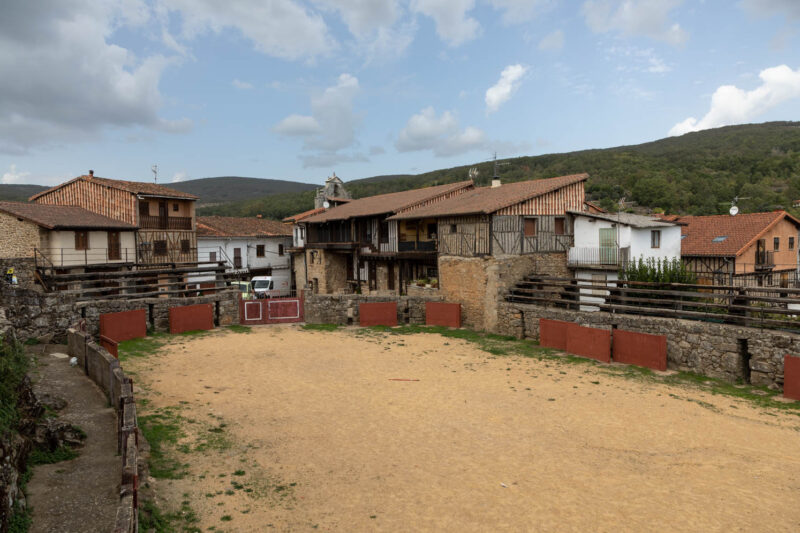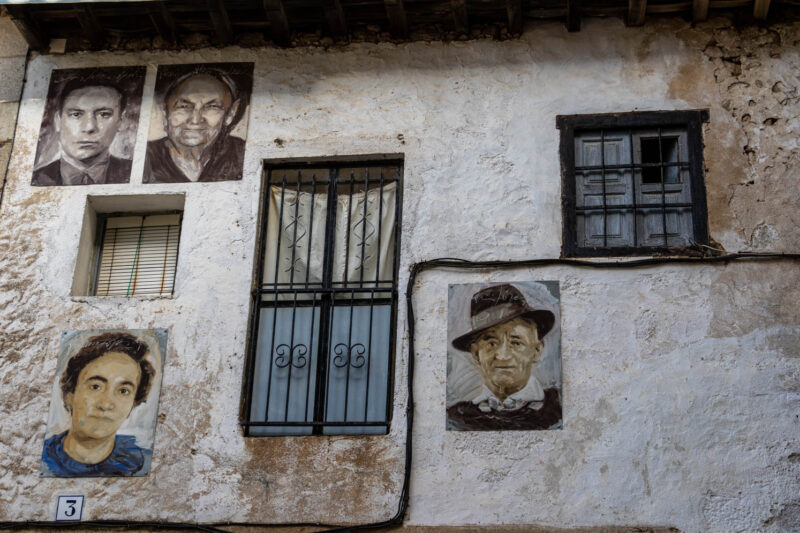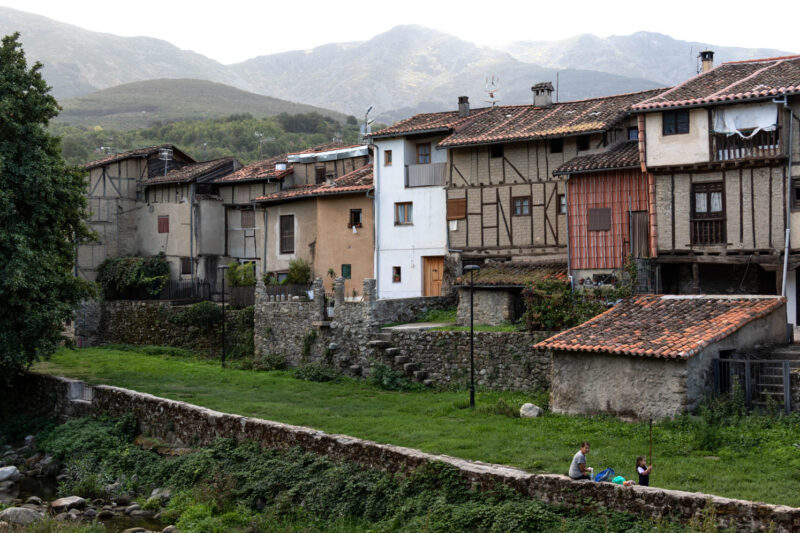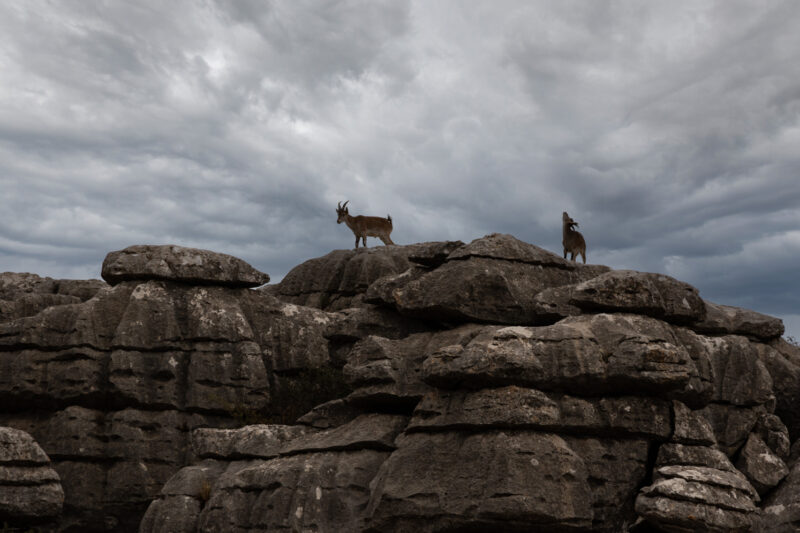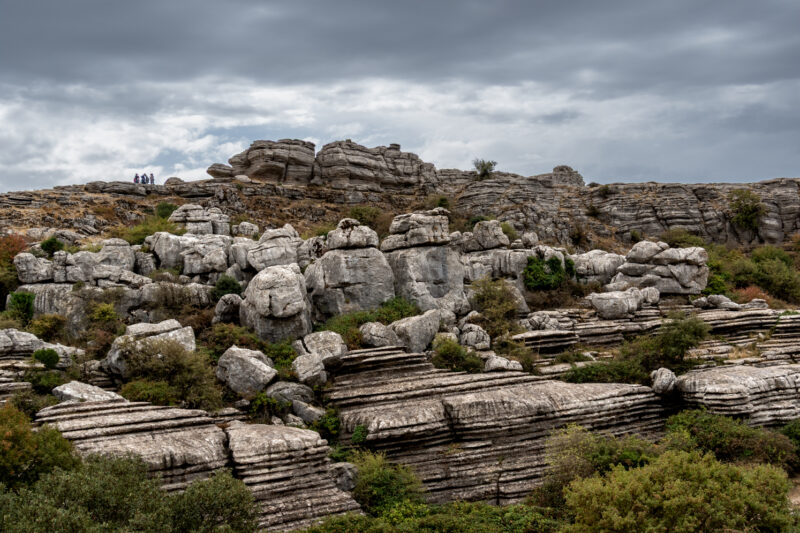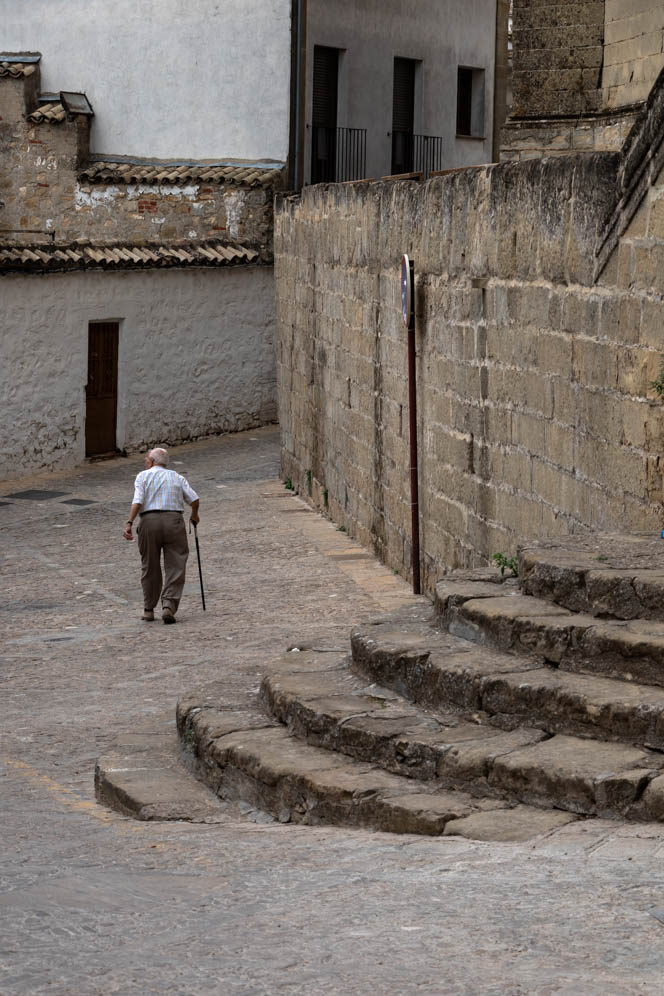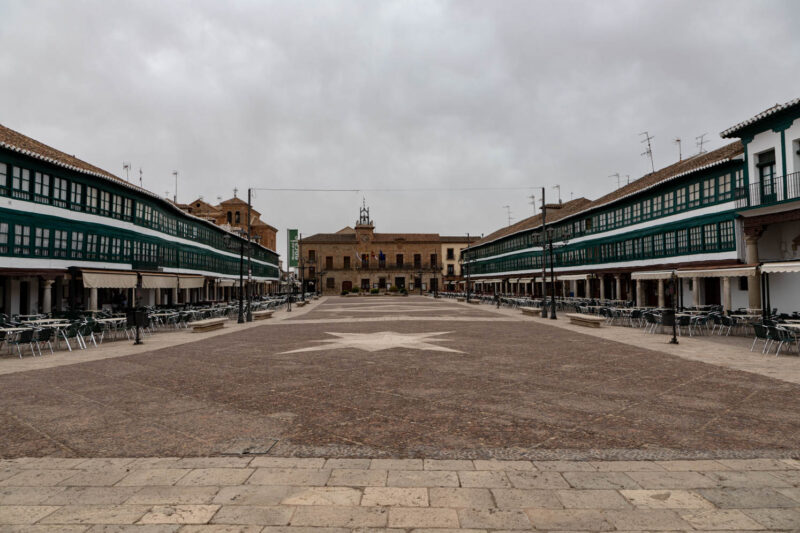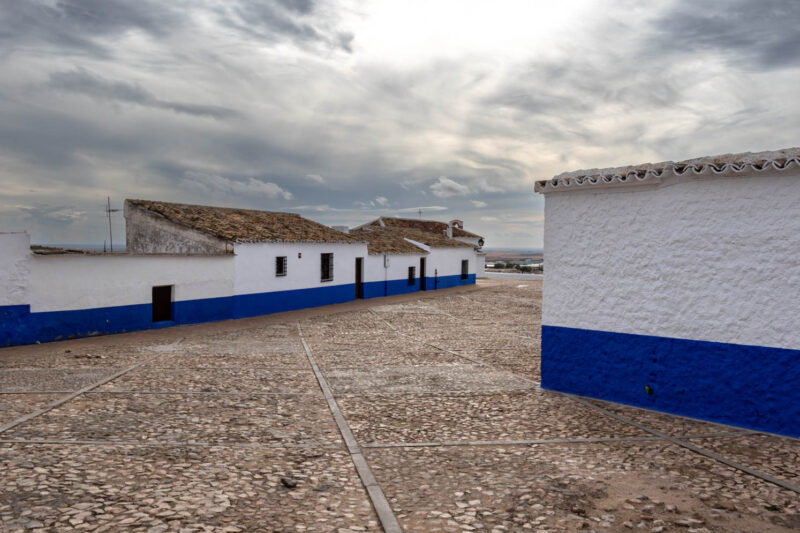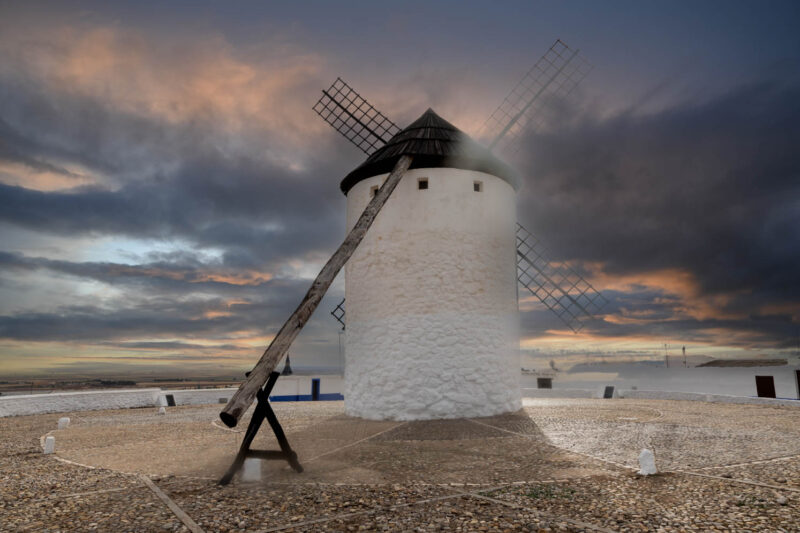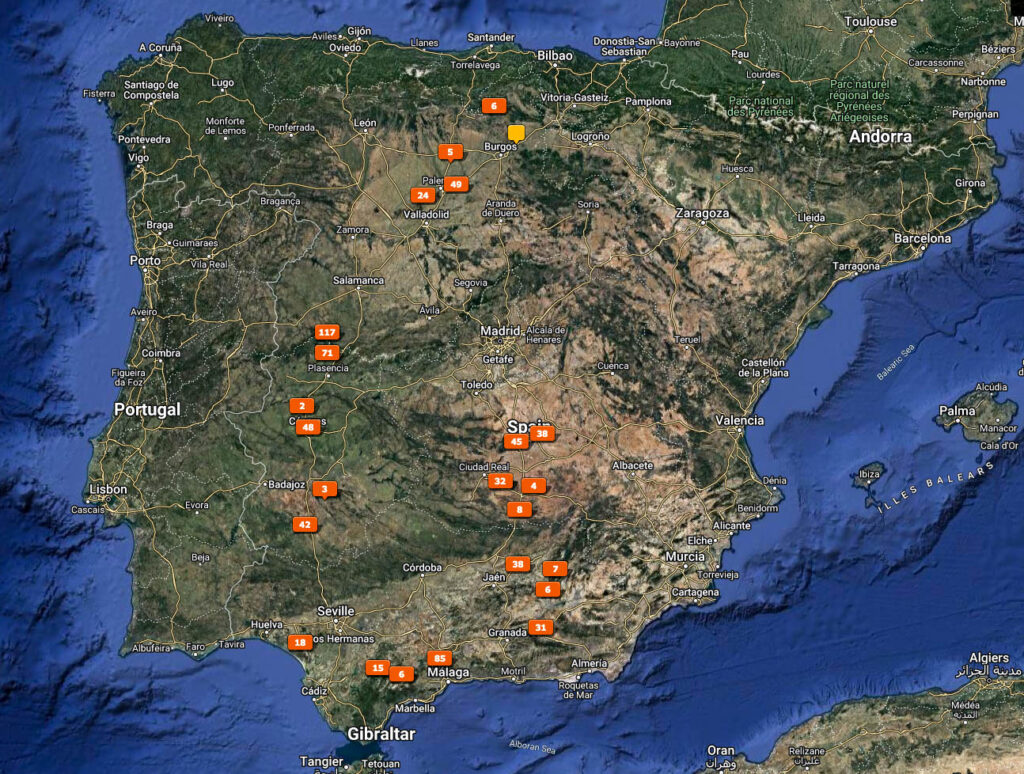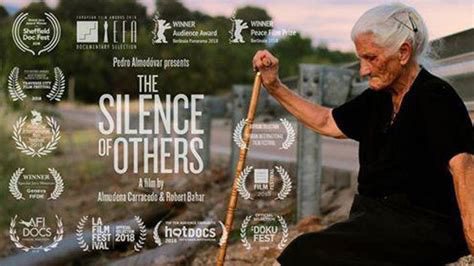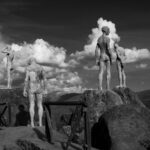Travelogue Spain 2022
travelogue
Spain 2022
In the autumn of 2022, we travelled through Spain from the north to the south and back, mainly inlands. The route we followed went through the regions: Castilla y León, Extremadura, Andalucía and Castilla-La Mancha.
We drove about 6.500 km during this trip, of which 4.000 km in Spain
Photo series
We have published all photos of this journey on SmugMug. Together with the photos that we made during earlier travels we have organised all photos in regional series. Here below, meant as a teaser, a small selection of the photos that we made in 2022. If you want to see the whole series please visit our photo site on SmugMug (click).
Route
- Zeeland – Buchy (FR)
- Buchy (FR) – Mirambeau (FR)
- Mirambeau (FR) – Monasterio de Rodilla (ES)
- Monasterio de Rodillo – Escalada – Orbaneja del Castillo- Aquilar de Campo- Frómista – Torquemada
- Torquemada – Palencia – Ampudia
- Ampudia – Salamanca – La Alberca
- La Alberca – Peña de Francia – San Martin del Castañar – La Alberca
- La Alberca – Mogarraz – Granadilla – Gabriel y Galán
- Gabriel y Galán – Segura do Toro – Hervás- Mirador de la Memoria – Gabriel y Galán
- Gabriel y Galán – Cáceres
- Cáceres – Embalse de Alange – Zafra
- Zafra – Minas de Riotinto
- Minas de Riotinto – El Rocio- Umbrete
- Umbrete – Sevilla – Arcos de la Frontera – Sierra de Grazelema – Zahara de la Sierra
- Zahara de la Sierra – Alora – Antequera
- Antequera – El Torcal de Antequera – Antequera
- Antequera – Guadix
- Guadix – Basa – Cazorla
- Cazorla – Sierra de Cazorla – Beas – Baeza
- Baeza – Las Virtudes – Almagro – Valdepeñas
- Valdepeñas – San Carlos del Valle – Campo de Criptana – Puerto Lapice
- Puerto Lapice – Consuegra – Vegas de Matute
- Vegas de Matute – Biarritz (FR)
- Biarritz – Oradour-sur-Glane (FR)
- Oradour – Vaas
- Vaas – Zeeland
Map of Spain with photo locations
Highlights of our trip
Orbaneja del Castillo
On our route along the origin of the Ebro, from Escalada to Aquilar de Campo, we stopped in Orbaneja del Castillo. Orbaneja is a hamlet in the municipality of Valle de Sedano and is located on the border of Burgos with Cantabria, embedded in a karst landscape. It is located in the Sedano Valley of the Hoces del Alto Ebro and Rudrón Natural Park and is surrounded by caves where its history originated.
The village is bisected by a 25-meter-high waterfall, which comes from the Cueva del Agua and flows into the river Ebro. If you look up from the bottom of the waterfall you do not expect the village to be so big. The village is set in a beautiful countryside and the village itself is well worth a climb.
Torquemada
A nice Spanish village. There is an interesting old bridge with many arches, but the most interesting are the bodegas located outside the village. These traditional underground cellars of Torquemada are of great cultural interest. They are built under an estimated area of 120,000 square meters. It is the largest wine district in Castilla y León, with 465 wineries.
Grouped into five areas of wineries, their most notable peculiarity is that they were excavated directly under a flat terrain, following a layout of rectilinear streets practically parallel to each other, and arranged in an east-west direction. Together with the Bodegas de Baltanás, a town near Torquemada, these areas of wineries form a unique heritage that is representative of a past and way of life related to the culture of wine.
Palencia
Palencia is a small town, located in the north of the Castilla y León region. It is a typical Castilian town, quiet and very attractive for its monumental and historical wealth. Known as Pallantia in Roman times, it was the place chosen by King Alfonso VIII of Castile to establish the first university in Spain in 1208. It currently has about eighty thousand inhabitants.
We strolled around in the area between Calle Mayor and Puente Mayor.
Ampudia
Located in the area known as Tierra de Campos, 22 kilometers away from the town of Palencia, Ampudia is a wonderful example of typical Castilian architecture and urban layout.
The imposing castle is located on the outside of the city, close to the remains of the city walls. With an elegant Gothic feel, it was built between the 13th and 15th centuries. It also contains an important archaeological and ethnographic collection.
Another characteristic monument is the neo-Gothic-Renaissance church of San Miguel. Because of its spectacular style, the 63-meter-high tower is known as the “Giralda de Campos”.
Traditional Castilian houses consist of two floors, made of clay and with arcades. These can be best seen in the Ontiveros and Corredera streets.
In 2018 we already visited Ampudia and we found it a small oasis amidst the dry farmland around it. We strolled and photographed the town in 2018, including an elderly couple sitting outside at the end of a hot day. Now four years later they were sitting outside together again with their daughter and granddaughter. We showed them the pictures from four years ago. They loved it. We took some pictures of the family together. When we got home we sent all the pictures we had taken to the granddaughter. We received a note back, that we are always very welcome in Ampudia.

La Alberca
La Alberca was the first rural village in Spain to be given the status of national historical heritage. La Alberca is located in the heart of the Sierra de la Peña de Francia.
Alleys paved with old pebbles, wooden balconies, natural stone houses and a nice Plaza Mayor make it a charming village.
Peña de Francia
The Peña de Francia with an altitude of 1,717 m, is one of the highest mountains of the Sierra de Francia in the Castilla y León region. In clear weather you have views of the mountains of Las Hurdes in the south, the hills of Portugal in the west, the Castilian plateau up to Salamanca in the north and the Sierra de Gredos in the west.
Unfortunately, the visibility was not so good when we were there, but the monastery, the Santuario de Nuestra Señora de la Peña de Francia, at the top made up for it. It is a Catholic church and sanctuary that sits atop the Peña de Francia and is a landmark for the surrounding villages.
San Martin del Castañar
In the heart of the Sierra de Francia Mountains lies Miranda del Castañar, a medieval town consisting of wooden buildings, typical of the mountains in Salamanca, and stone houses with coats of arms.
Very special is the Plaza de Toros. The arena is one of the oldest in Spain. It is located in the middle of the village. Originally it stood on the old parade ground of the adjacent castle, of which only a ruin remained. It is a special arena, because it is characterized by its peculiar shape between oval and rectangular. It consists of three permanent stands and a fourth will be installed as bullfighting approaches every August 11, coinciding with the patron saint festivals.
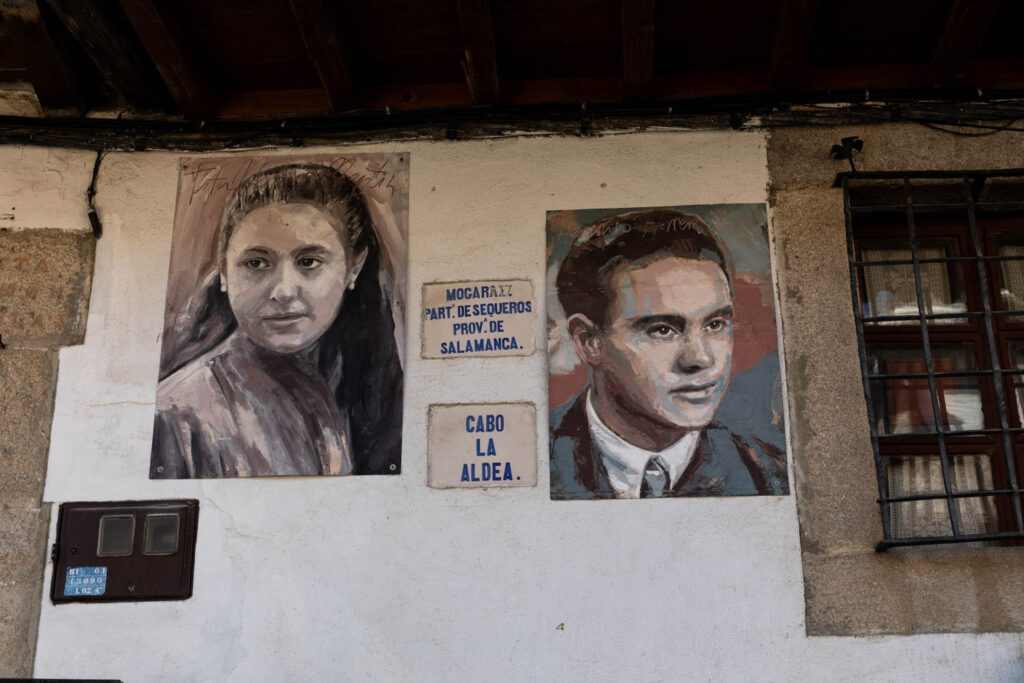
Mogarraz
On the way to Béjar we saw painted portraits hanging on several houses when passing by the village of Mogarraz. It caught our attention and we decided to park the camper and explore the village. To our surprise, we saw that portraits were placed on almost all houses. Portraits of the people of the village, of the people who live or have lived in the houses.
It’s a special story. The portraits are based on a series of 388 photographs taken by Alejandro Martin in 1967. He took the photos to help his villagers with ID cards. Due to the poor economic conditions, many people wanted to emigrate and needed an ID card. Fifty years later, a local artist began painting the photographs on large panels. The name of the painter is Florencio Maillo. The paintings now hang on the houses of the village, making the village an “outdoor art gallery”.
It was a big surprise for us. A wonderful exhibition. We took a lot of pictures. We couldn’t stop. The circle is complete now. From photo to painting, from painting back to photo.
Granadilla
In 1955, the population had to leave Granadilla when the Spanish government decided to build a reservoir.
It was a bit disappointing for us. There was (too) much cordoned off due to the risk of collapse and due to restoration work. In a few years it may be worthwhile to visit Granadilla again. Granadilla is in a beautiful area and the reservoir I understand is an ideal place for bird watching.
Embalse de Gabriel y Galán
The Gabriel y Galán reservoir was formed by damming the water of the Alagón River. It is in the north of the province of Cáceres, in Extremadura. It got its name as a tribute to the Salamanca poet José María Gabriel y Galán. After a series of projects, the first dating from 1902, work on the reservoir began in late 1952 during the Franco dictatorship and was completed in 1961.
We spent two nights there with our camper, with a beautiful view of the reservoir. It was deafeningly quiet at night.
Hervás
Hervás is located in the north of the province of Cáceres. It is the capital of the comarca Valle de Ambroz in the valley of the river Ambroz. The most characteristic hallmark in the historical heritage of Hervás is the Jewish Quarter (Juderia). The narrow, steep streets are lined with houses that come together like grapes, and are made with adobe and chestnut wooden frameworks, their roofs plastered with Arabic tiles for protection against the wind.
We mainly strolled through the Juderia and tried to capture the atmosphere in our photos. Hervás has an interesting Jewish history. It was a refuge for Jews who wanted to flee from the ongoing persecution that took place centuries ago throughout the country. I have the impression that the city and its inhabitants are proud of the Juderia and of the successful integration of the Jews into their city.
Mirador de la Memoria
The Silence of Others, filmed over a six-year period, reveals the epic struggle of victims of Spain’s 40-year dictatorship under General Franco, as they organize a groundbreaking international trial and fight a “pact of forgetting” around the crimes they have been inflicted. The film offers a cautionary tale about fascism and the dangers of forgetting the past
We saw the movie not so long ago. The film touched us, and we admired the victims. We found out through the film that a monument to the victims had been erected in the Jerte valley. A beautiful monument. In 2018 we were in the Jerte valley, but in our travel books at the time, incomprehensibly, nothing or very limited was written about the monument. It was important for us to visit the monument on this trip
The monument has a name that lives up to it: Mirador de la Memoria. The location does the same, in the Jerte valley, at a viewpoint with the Sierra de Tarmontas in the background. Francisco Cedenilla is the creator of the sculptural work. The monument, consisting of four human figures, was inaugurated in January 2008. A woman and three men, two young men and an old man, were placed on huge granite stones.
The four figures focus their attention on different places in the valley, but their gaze is lost. It makes them feel confused, lost, abandoned. Cedenilla conceived this work as a tribute to all the victims of the Civil War, especially to his grandfather, who died in front of a firing squad in October 1936. “Leonardo Cedenilla, you are in our memory”, can be read in the figure of the old man.
Three of the figures have bullet holes, because someone shot at the monument in the days after the inauguration. It could have been restored, but Cedenilla did not want this, for there was no better way to show the meaning of his work. When you click on one of the moviestills below you will be directed to the website of the film.
Cáceres
Cáceres is one of the most beautiful cities in Spain. We immediately felt at home in this historic city. The light was very nice when we were there. Then it is a gift to stroll through such a wonderful city and take photos.
The city was placed on the list of World Heritage sites by UNESCO in 1985. When you walk through the old town you imagine yourself in the Middle Ages. Cáceres is built on the remains of a walled Roman city. After that it was in the hands of the Moors for 900 years. In the Middle Ages, the city was finished and not changed.
Spain’s tourist website described Cáceres as follows:
This historic town in Extremadura, known as “the city of 1001 coats of arms”, is worth a visit. You may feel like a time traveler as you walk through one of the narrow cobblestone streets. Surrounded by mansions, Renaissance palaces, and churches crowned by stork nests, you’ll understand why Cáceres is a World Heritage City.
We therefore fully agree that you should not skip this city on your trip!
Zafra
Zafra is a charming Spanish town, located in the province of Badajoz (Extremadura). It is called little Seville. It has a nice atmosphere. The city is dominated by the 15th-century Alcázar (fortress). From the outside it has a military look, but the interior looks like a palace. The medieval quarter stretches around the fortress, in a network of narrow streets that form a peculiar pattern resembling the scale of a turtle. A stone wall from the 15th century completely surrounds it; today, only three of the eight gates it used to have are still standing.
Plaza Grande (Great Square), lined with arches, is in the heart of the city. Its little sister, Plaza Chica (Small Square) is connected to it by the popular “Arquillo del Pan” (the little arch of bread). Around it, nice streets with characteristic buildings. The church La Candeleria is impressive.
El Rocio
On TV we had seen images of El Rocío during the Pentecost days.
More than a million people and almost a hundred different religious associations enjoy the special festive atmosphere of the pilgrimage to El Rocío. The celebration combines religion and celebration and is held 50 days after Easter. Hundreds of thousands of people come from all over Spain, and even from abroad, to make this annual pilgrimage to the sanctuary of La Blanca Paloma in the village of El Rocío, 17 kilometers from the city of Almonte (province of Huelva).
The décor is fantastic. The roads of the village are made of sand. The buildings are white. The church, the Santuario Nostra Signora del Rocío, stands spectacularly in the middle of the village, in the sand. I think that’s what Mexico looks like. Too bad we weren’t there during the pilgrimage. We were there in the middle of the day, it was very hot, very quiet. We missed the horses.
Zahara de la Sierra
Located in the northwest of the province of Cadiz in the hills of Andalucía, almost all the municipal area belongs to the Sierra de Grazalema Natural Park. The village, once a Nazari border fortress, sits atop a hill, at the foot of the castle’s remains, and consists of streets of stepped white houses built on the mountainside; therefore this village is considered one of the most attractive in the province.
The current name comes from the Arabic ‘zahra’ which means ‘flower’.
Antequera
Antequera is a city and municipality in the Comarca de Antequera, province of Málaga, Andalucía. It is known as “the heart of Andalucía” (el corazón de Andalucía) due to its central location between Málaga, Granada, Córdoba and Seville. Antequera is one of the most important cities of Andalucía. It is the largest municipality in the province, mainly consisting of a very fertile plateau where olive trees and cereals grow, surrounded by the Sierras de El Torcal and the Arco Calizo Central (Central Limestone Arch).
Highlights we found La Alcazaba, but also the churches Santa Maria La Mayor and Iglesia del Carmen. In the upper town you have beautiful views over this impressive city. We spent two nights in Antequera. From our camper we had a view of La Alcazaba. We strolled and photographed through the city on Sunday. It is a very beautiful city. On the late Sunday afternoon, people paraded through the streets and enjoyed the wonderful October weather.
El Torcal de Antequera
El Torcal de Antequera is known for its unusual limestone rock formations. It is located about 30 km north of the city of Málaga in the direction of Antequera near the village of Villanueva de la Concepción. Within the 17 square km of the El Torcal Park are some of the most beautiful and impressive limestone landscapes in Europe. The whole area was under water (sea) until a hundred million years ago.
The road to it from Antequera is impressive. It goes through a mineral landscape, with the mountains of the Sierra Tejada in the background. We made a walk of about 2.5 hours. For Precious, one of our dogs, it was challenging because of the various surgeries she has had on her hind legs in the past. The scenery is truly breathtaking. We also saw wild goats. It is a miracle that they can move so well on these steep mountain slopes.
Guadix
Guadix is located in the province of Granada. The city is located at an altitude of 913 meters in the center of the Hoya of Guadix, a plateau on the northern foothills of the Sierra Nevada.
When you enter the city, the imposing cathedral is in front of you. It is an immense structure and the center of Guadix. The main attraction of Guadix are the cave dwellings, carved into the surrounding hills. There are about 2000 cave houses. Although from the viewpoint of La Magdalena, the view of the cave dwellings is spectacular, I still think that the original character has disappeared. Many houses have been beautifully restored, but the character of this cave district has changed as a result.
Sierra de Cazorla
Sierra de Cazorla is a mountain range in the province of Jaén in Spain. It is named after the city of Cazorla. The highest point is the 1,847 m high Gilillo peak. This is the largest protected nature reserve in Spain. These 200,000 hectares of mountain landscape is located northwest of Jaén, with leafy pine forests.
Here rise the Guadalquivir (at the place known as the Cañada de las Fuentes, at an altitude of more than 1,330 meters) and the Segura rivers. The reserve is home to the Spanish ibex, red deer and wild boar, as well as mouflons, which can be seen in semi-captivity in the Collado del Almendral wildlife park.
We made a trip through the Sierra de Cazorla, along the Embalse del Tranco.
Baeza
Baeza is a small town, with a pretty historic center and is located in the province of Jaén, in Andalucía. It is especially famous for Italian Renaissance architecture in Spain. Along with neighboring Úbeda, it was added to the UNESCO List of World Heritage Sites in 2003.
This ancient and illustrious city is located in the geographical center of the province, near the River Guadalquivir, in a landscape of fertile soils rich in vegetable and grain fields and olive groves.
A quiet and peaceful city, of almost Castilian appearance, of exceptional beauty, with an architectural treasure that is hard to find elsewhere. A city where the Renaissance shows all its splendor, a city that inspired Antonio Machado and that offers unforgettable sights around every corner: palaces and churches next to white houses, facades, porches, towers, squares, and fountains.
The land of La Mancha
Las Virtudes
8 kilometers from Santa Cruz de Mudela, is the hamlet of Las Virtudes. It houses two special buildings, an old hermitage and a special bullring.
The old hermitage, the Capella de Nuestra Señora de las Virtudas, of the sixteenth century is a church built in several stages. Initially it was a very small church of the rural type, it had little height, and the ceiling was of Mudejar style, the floor of stones from the area that have a marble appearance. After the appearance of the Virgin of Virtues in the early seventeenth century, the expansion of the church began.The arena was built next to the primitive hermitage with materials from the area, decorated with wood of Mudejar motifs. It is considered the oldest square arena in the world that is still intact. In 1981 it was declared a National Artistic Monument.
The Mudejar style (Spanish: estilo mudéjar) occurs exclusively in Spain and can be described as an art style in which two artistic traditions, namely the Islam tradition on the one hand and the Christian tradition on the other hand, go together.
We especially liked the extraordinary combination of church and arena.
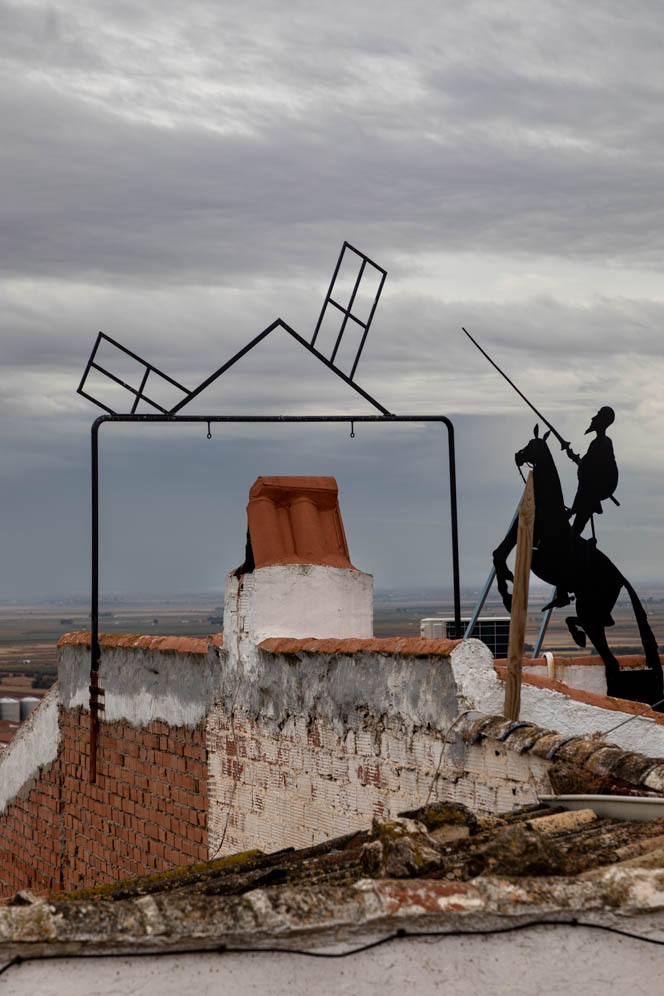
Almagro
Almagro is a municipality in the province of Ciudad Real. Almagro has been designated as Conjunto histórico, a kind of protected area. Almagro is a beautiful city, with houses whose facades are decorated with coats of arms and baroque portals.
As in almost all Castilian cities, the center is the Plaza Mayor. It is very characteristic, because of the colonnades and the green painted window frames. We have also been to the Corral de Comedias, which is the oldest theatre in Spain.
Campo de Criptana
Campo de Criptana is a municipality located in the province of Ciudad Real, Castilla-La Mancha. Along with Consuegra and Alcázar de San Juan, it has many of the typical mills that Don Quixote fought against in Cervantes’ book, making it a hallmark of La Mancha. Of the ten mills in Campo de Criptana, three date back to the 16th century: Molino Burleta, Molino Infanto and Molino Sardinero. Campo de Criptana is one of the most famous places of the Don Quixote route.
The Don Quixote route refers to the journey that the main character of the novel, El ingenioso hidalgo Don Quijote de la Mancha, followed in his adventures through mainly the land of la Mancha, but also Aragon and Catalonia.
Windmills
A 19th-century land registry shows 34 windmills that existed at the time, each clearly marked with the name of the mill and that of its owner. The ten windmills can be seen from afar. Their original structure and mechanism have been preserved. In 1978, the entire group of windmills was declared a cultural heritage site.
We spent the night at a small camper place in Puerto Lapiche. The place where Don Quixote was knighted by the innkeeper.
Consuegra
Consuegra is a municipality in the province of Toledo, Castilla-La Mancha, Spain. Located at the foot of the Cerro Calderico ridge, it has an impressive castle and several of the windmills typical of La Mancha. Five of the twelve windmills still have their original mechanism and one of them is known as “Sancho”.
The windmills of Consuegra stand in a beautiful spot with impressive 360-degree views. It is a beautiful view together with the castle. At this place, but also in Campo de Criptana you would like to come back under various lighting conditions. I think La Mancha is a very beautiful region. Because Don Quixote is everywhere here, it gets something magical. As soon as we got home, we bought Cervantes’ novel to follow Don Quixote again on his adventures as a wandering knight.
Travel guides
- Extremadura – Crossbill Guides
In the Dutch travel report more travel guides are listed.
Comments are closed.




